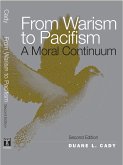Peace is not always an ideal condition for a state, or even a person to be in. Yet there exist many examples of lasting peace agreements between formerly belligerent countries. One of the best examples is the peace between the U.S. and Great Britain that has held since before the Civil War and became a formalized alliance during the World Wars, despite the Revolutionary War and the conflicts that followed as the U.S. struggled for sovereignty and international recognition. Similar cases can be seen worldwide, though there have been few studies to see why peace occurs under these circumstances and not others. Perhaps the most effective proof of peace is a formal treaty between the belligerents. The problem is that through the process of negotiation, states will often stand firm in their demands. Agreements on the most important issues are often glossed over or left deliberately vague with intention to return to make the wording stronger in order to have some sort of agreement. However, weaknesses of these same agreements are later used as a reason for breakdown and termination of treaties and the reintroduction of a state of war. This would lead to a belief that peace is only as strong as the agreement on paper holding it together. One must then ask how important is the agreement as compared to other conditions for maintaining a stable peace. Therefore, this thesis will serve to answer two questions: How much of the maintenance of peace between two or more states is attributable to the signing of a formal treaty document, and how much to conditions either before or after the treaty has been reached? Furthermore, what process of negotiation and bargaining enables states to maintain a stable peace?







